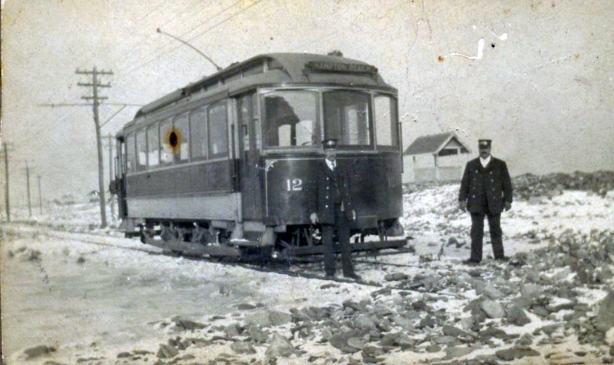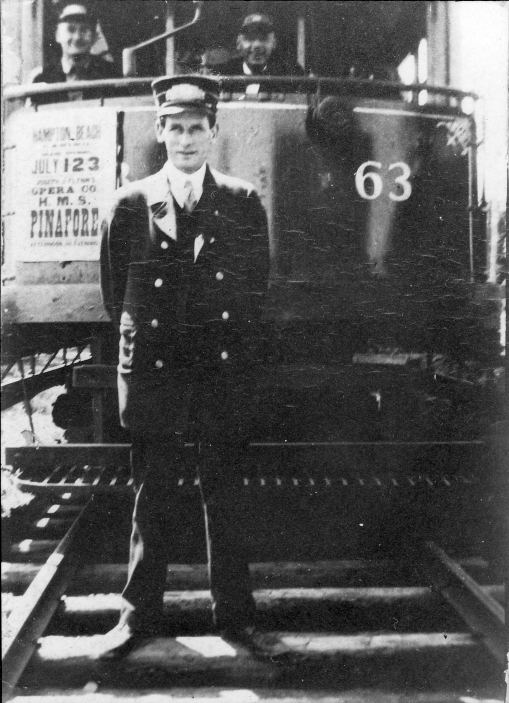Written by O. Richard Cummings
From: Transportation Volume 5
Published June 1951
by the
Connecticut Valley Chapter, National Railway Historical Society, Inc. &
Connecticut Valley Division, Electric Railroaders’ Association, Inc.
Warehouse Point, Connecticut

DUPLEX CAR NO. 20 — A Briggs single track early-type convertible car built in 1899, is shown at the Exeter railroad depot. It was the only car of its type owned by the Exeter, Hampton & Amesbury Street Railway, and was used extensively for special parties, being decorated with colored lights and bunting for such occasions. During the last years of operation of the railway, this car was set up on barrels in the Hampton carhouse. [Photo by George Allen, Hartford, Conn.]
A TYPICAL New England side of-the-road country trolley line connecting the small towns of Exeter, Hampton, Hampton Falls, and Seabrook, in the southeastern section of New Hampshire’s Rockingham County, and extending via leased trackage into northeastern Massachusetts for a number of years — the Exeter, Hampton & Amesbury [Street Railway] has been but a memory for the past quarter of a century.
Formed during the spring of 1899 as a consolidation of the Exeter Street Railway, the Hampton & Amesbury Street Railway and the Rockingham Electric Co., all three of which had been promoted and were controlled by the same interests, the Exeter, Hampton & Amesbury had a colorful history, beginning with the incorporation of its earliest predecessor in 1889 and continuing through a period of enthusiastic promotion, extensions and consolidations, to the more than 20 years of financial difficulties — two decades that saw bankruptcy, receivership and reorganization, staggering deficits and finally municipal ownership and operation and motorization — which ended with complete abandonment in [May] 1926.
The Exeter, Hampton & Amesbury Street Railway served as the nucleus around, which many of the lines later merged into the Massachusetts Northeastern Street Railway were built. Although itself never becoming a part of the Northeastern, it was one of the latter’s more important connections — forming one of the two New Hampshire links in the chain of electric railways extending from New York City to Augusta and Waterville, Maine!
Foreword
BECAUSE of the absence of official records, all of which were destroyed many years ago, the compilation of this history of the Exeter, Hampton & Amesbury Street Railway was a very difficult task. Basic information was taken from the annual reports of the New Hampshire Railroad Commissioners and the Public Service Commission. Other data was secured through extensive research in files of local newspapers and of the long-defunct “Street Railway Journal” and “Electric Railway Journal” and from old trolley guides and timetables, including an illustrated brochure published by the Exeter, Hampton & Amesbury Street Railway in 1900.
Grateful acknowledgement is made for valuable assistance rendered by several former employes of the road, including Benjamin L. Colby and Lee H. MacKenzie, both of Amesbury, and L. Frank Stevens of Hampton. Many others have contributed photographs and various items of information. Their aid is greatly appreciated.
23 Main Street
Amesbury, Mass.
September 1, 1950.

The Exeter, Hampton & Amesbury St. Railway
The Portsmouth & Exeter St. Railway
The Amesbury & Hampton St. Railway
The Seabrook & Hampton Beach St. Railway
The Haverhill. Plaistow & Newton St. Railway
The Haverhill & Plaistow St. Railway
– – – – – Connecting Lines
Exeter Street Railway Company

THE EXETER STREET RAILWAY, as the oldest of three companies merged to form the Exeter, Hampton & Amesbury Street Railway in 1899, was chartered in perpetuity by special act of the New Hamsphire State Legislature on August 7, 1889, and was authorized to build and maintain a railroad to be operated by electricity from any point in the town of Exeter to any point in the town of Hampton. It was intended to build from the Boston & Maine Railroad depot in Exeter to Hampton Village and Hampton Beach, a distance of slightly more than 12 miles. Efforts to finance the enterprise locally met with failure and the project lay dormant for a number of years.
Early in 1897, a group of promoters from Massachusetts, led by Wallace D. Lovell, who had previously organized the Franklin Construction Company for the purpose of building electric railways, became interested in the Exeter Street Railway. The original incorporators were more than willing to have outside parties finance the railway. Within a short time, an agreement was drawn up whereby the Franklin Construction Company was to build and equip the Exeter Street Railway; and the latter was to convey to the construction company such capital stock and bonds as it was authorized to issue, with the exception of 10 shares of stock turned over to the directors of the railway.
At about the same time, Wallace Lovell organized the Rockingham Electric Company. This new utility, chartered on March 19, 1897, was to purchase electricity and power from the Exeter Street Railway and sell these services to the towns of Exeter and Hampton and to the residents of those communities, something which, under its charter, the Exeter Street Railway was not permitted to do.
The entire cost of constructing the railway and power plant was to be met through the sale of the Exeter Street Railway’s stock and bonds, the securities of the electric company remaining in the hands of Lovell and his associates.
These arrangements were severly criticized by the Board of Railroad Commissioners who, in their 1897 report, said in part:
“- – – the construction company has contracted with the street railway company to build and equip a railroad from Exeter to Hampton Beach and receive in payment such stock and bonds as can be legally issued. It is arranged that the street railway company shall furnish to the power company such light and power as the latter can sell to the towns of Exeter and Hampton and to the residents of those towns. In other words, Mr. Lovell and his associates, as the construction company, have contracted with themselves, as the railway company, to build and equip a railroad – – – and they propose, as the electric company, to take from the railway company, at a price fixed by them, such light and power as they can find a market for. All of these contracts being with themselves, it is for them to decide what kind of a railroad they will construct and what they will pay for the light and power they sell.
“Assuming that the bargains and contracts which these men have made with themselves are binding upon the street railway, the owners of the railway securities, who furnish all the money, will be at the mercy of the construction company until the road is completed and of the electric company afterward.
“We place upon record our disapproval of the arrangements by which those in control of the corporations have placed themselves in a position in which, if they are so disposed, they can prey upon the property of the railway company after disposing of its securities and we suggest to all concerned a radical modification of the plans and practices of the managers of this enterprise so as to bring them within the law.”
Evidently matters were subsequently adjustged to satisfaction of the Railroad Commissioners for no further criticisms appear in later reports.
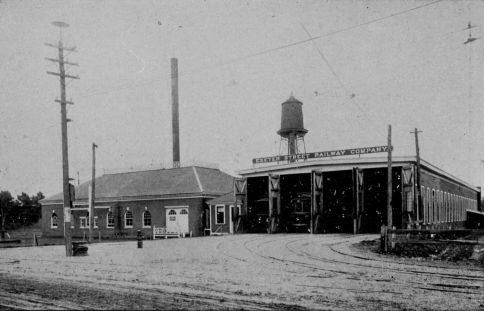
ORIGINAL HAMPTON CARHOUSE-Built in 1897 by the Exeter Street Railway, it was destroyed by fire on March 1, 1907. Cars on tracks 1 and 2 are a 10-bench single truck open and No. 20, a Briggs-built single truck Duplex car. [Photo from collection of 0. R. Cummings.]


THE FIRST RAIL of the Exeter Street Railway was laid in Hamptyon Village near Whittier’s Hotel on Winnacunnet Road, on the morning of May 19, 1897, and from that day on, construction proceeded rdapidly, with heavy “T” rail and hardwood ties being laid on thaick gravel ballast which was used throughout. A carhouse and the power plant were built about a mile est of Hampton Center, midway between eExeter and Hampton Beach. Rolling stock was pusrchased from the BRIGGS CARRIAGE COMPANY, Amesbury, Mass.
The car house was a wooden building, 200 feet long and 50 feet wide, held four tracks and had a capacity of about 20 singe truck cars. At the rear of the carhouse, and separated from the rest of the building by a fireproof brick wall. was a completely equipped repair shop and stock room.
The power station was a brick structure, 80 by 100 feet in area, and was divided into a boiler room. a pump and condenser room and a power room. For equipment, there were three Ames tubular boilers, three 185 hp. Buckeye engines, two 125-kw/550-volt Keystone generators for trolley power and two generators for lighting service.
Both the carhouse and power station were protected against fire with dry air automatic sprinkler systems. To insure the safety of the railway’s operations, a telephone dispatching system, connecting the carhouse with the line’s terminals and turnouts, was installed.
Initial passenger rolling stock comprised five 10-bench single truck opens and five 20-ft. single truck closed cars (three with enclosed vestibules and two with open platforms). Other rolling stock included a single truck box freight car, a single truck trailer flat, two 4-wheel Taunton nose plows, a horse-drawn tower wagon and a buggy.
THE FIRST CAR over the Exeter Street Railway entered Court Square in Exeter from Hampton carhouse in the late afternoon of July 5, 1897, and a day or so later, regular service between Exeter and Hampton Village was begun. It was not until July 9th that the railway was completed to Hampton Beach, the line extending to a point near the old Cutler’s Hotel.
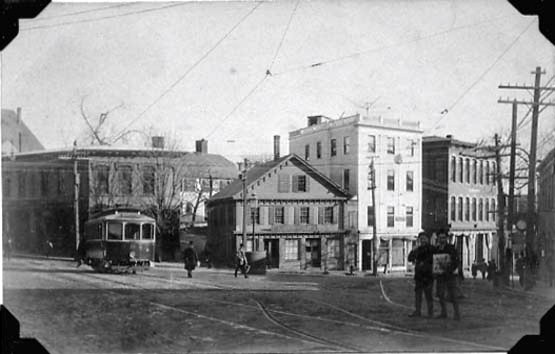
NO. 8 AT MARKET SQUARE, AMESBURY, was immediately placed in 1900. This car some years later became the kitchen of the Hampton Diner. [Photo from collection of O. R. Cummings.]
A half-hourly schedule was immediately place in effect between Exeter and Hampton Beach and continued until late September when hourly time was run for the fall, winter and early spring months.
There were three fare zones: (1) from Court Square-the junction of High, Front and Water Streets-in Exeter to the Exeter Hampton town line; (2) from the Exeter-Hampton town line to Hampton Center; (3) from Hampton Center to the end of track at Hampton Beach. The fare was five cents per zone, with a special round trip rate of 25 cents from Exeter to Hampton Beach and return.
In addition to its passenger service, the Exeter Street Railway also handled freight and express. The roads leading to Hampton Beach were very poor and the railway’s freight car, frequently towing the flat trailer, was continually in use hauling furniture, baggage, lumber and other goods from Exeter and the Hampton depot to the rapidly-developing summer resort.
During its first year of operation, the railway carried 554,849 passengers, which together with receipts from mail and express, and miscellaneous income, produced $29,022.97 in gross revenue. Operating expenses totalled only $19,217.14 and bond interest $4,875 to leave a net income of $4,930.38. Additional figures for this first year reveal that 6,625 round trips from Exeter to Hampton Beach were operated, for a total of 159.000 car miles.

NO. 6 IN EXETER — On Water St., circa 1898. This Briggs-built 20-ft. closed-car was used on the Exeter, Hampton & Amesbury St. Ry. until 1921. [Photo from collection of Charles C. Holt.]
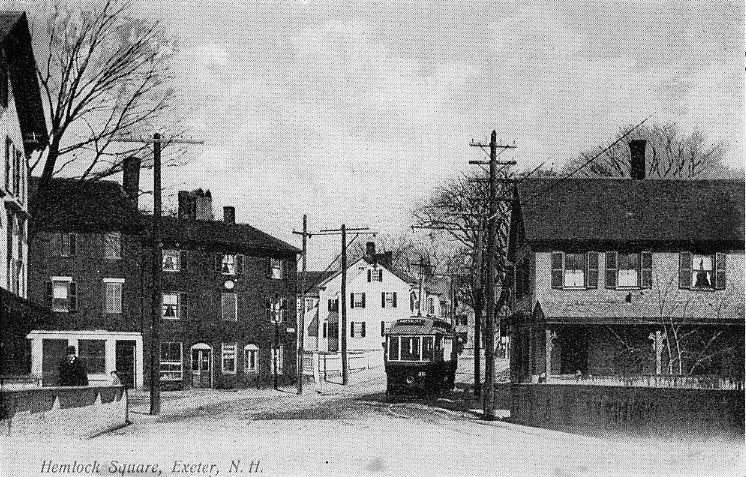
A trolley approaches the Exeter River bridge in Exeter [From the collection of O.R. Cummings]
Extensions and Improvements
Hampton & Amesbury Street Railway
EARLY IN 1898, Lovell and his associates began to plan for the extension of the Exeter Street Railway, and it was decided to build from Hampton Village, along the Lafayette Highway through Hampton Falls and Seabrook, to Smithtown Square in the latter town and to the Massachusetts state line. Here a connection was to be made with a branch of the Haverhill & Amesbury Street Railway, which was to be extended from Salisbury Square.
Due to the limitations of the Exeter Street Railway’s charter, which permitted it to operate in Exeter and Hampton only, it could construct only that portion of the Hampton-Smithtown route between Hampton Village and the Hampton-Hampton Falls town line. Another company had to be organized to build the rest of the line. This company, the Hampton & Amesbury Street Railway, was incorporated on June 13, 1898.
At about the same time, construction began on a loop in Exeter, extending from Court Square, up Front Street to the B. & M. railroad crossing; through Garfield and Lincoln Streets to the railroad station, and thence down Main and Water Streets to return to Court Square. With the opening of this loop in the latter part of 1898, the fare limit was extended from Court Square to the depot. The fare around the loop itself was 5 cents.
Construction on the Hampton Village-Smithtown line began in November 1898, but a heavy snowstorm toward the end of that month forced a halt to all work until the spring of the following year.
Amesbury & Hampton Street Railway
IN THE LATE FALL of 1898, Lovell decided to build an extension from the state line at Smithtown directly to Amesbury via Salisbury Plains, and accordingly secured necessary franchises from the two towns. Because this extension would be in Massachusetts, a company incorporated in that state had to be organized. On January 27, 1899, the Amesbury & Hampton Street Railway was chartered by the legislature of the Bay State.
The building of the Amesbury & Hampton Street Railway, which was to complete a direct route from Amesbury to Hampton Beach and to Exeter, was strongly opposed by Edward P. Shaw, president of the Haverhill & Amesbury Street Railway, and there were rumors for many days that the Haverhill & Amesbury would take over the Amesbury & Hampton. Conversely, there were reports that Lovell would purchase the Haverhill & Amesbury in order to secure a route to Haverhill. Neither event materialized, and construc tion work soon began on the Amesbury & Hampton, a contract being awarded to Soule, Dillingham & Company, Boston, which firm was also building the Hampton & Amesbury Street Railway.
A carhouse site was purchased on Clinton Street, Amesbury, and a brick building, practically identical in size and style to that of the Hampton carhouse, but minus the repair shop, was erected. The passenger equipment (six 14-bench double truck and three 10-bench single truck opens and two 20-ft. single truck closed cars) was purchased from Briggs Carriage Co.


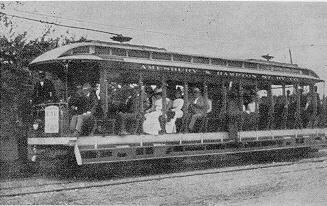
EN ROUTE from Amesbury to Hampton Beach one of the Briggs 14-bench opens of the 25-35 class is shown. These cars later became the 53-63 class of the Massachusetts Northeastern Street Railway [Courtesy Haverhill Public Library]
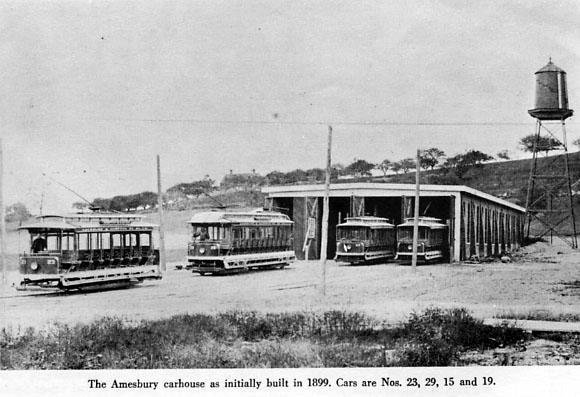
AMESBURY CARHOUSE-Built by the Amesbury & Hampton St. Ry. in 1899. Cars shown are No. 23, Briggs 10-bench 4-wheel open; No. 29, Briggs 14 – bench double truck open (later Mass. Northeastern St. Ry. No. 57) and Nos. 15 and 19, both Newburyport 10 – bench single truck opens [Photo from collection of 0. R. Cummings]
Consolidation
Exeter, Hampton & Amesbury Street Railway
THE EXETER, HAMPTON & AMESBURY STREET RAILWAY was incorporated in New Hampshire on Feburary 15, 1899, and was authorized to acquire, within two years, all the assets, properties and franchises of the Exeter Street Railway, the Hampton & Amesbury Street Railway and the Rockingham Electric Company. The consolidation was to be accomplished through the exchange of stock and bonds on an equal basis. At a stockholders’ meeting held on May 20th, the terms of the Exeter, Hampton & Amesbury’s charter were adopted and shortly thereafter the corporate existences of the three merging company were legally dissolved and the Exeter, Hampton & Amesbury Street Railway formally took over.
Construction on the Hampton Village-Smithtown route was resumed on April 19, 1899, and on May 12th the first car ran from Hampton to Hampton Falls. Two days later, regular service was being operated between Hampton and Locke’s store in Seabrook, and by May 24th cars were running between Smithtown and Hampton, connecting at Smithtown with cars from Amesbury and Newburyport via the Haverhill & Amesbury Street Railway, and at Hampton with cars on the Exeter-Hampton Beach route.
In the meantime, the Amesbury & Hampton Street Railway was being rushed to completion, and at 5:30 p. m. on July 3rd, the first car entered Market Square in Amesbury. During the next hot*’Y the car made two round trips from Amesbury to Smithtown, a group of youngsters taking the first ride and a number of Amesbury town officials and residents riding on the second trip. Regular service from Amesbury to Hampton Beach began at 7 o’clock the next morning, Independence Day.

MAIL CAR NO. 18-At Exeter depot, 1900. Nicholas Walsh of Amesbury, motorman of the mail car for many years, is shown at the right; the conductor on the left is unidentified. Use of the mail car was discontinued in 1910, and the car body was later sold for use as a henhouse [Photo from collection of Howard T. Mouton]
Scarcely more than three weeks after the Exeter, Hampton & Amesbury-Amesbury & Hampton system began operation, the first of many “Amesbury Days” was held at Hampton Beach, with the railway being called upon to carry more than 2,000 passengers from Amesbury to the beach in the morning and back to Amesbury in the evening. A few days later, a physical connection was effected between the Amesbury & Hampton and the Haverhill & Amesbury Street Railways in Market Square, Amesbury, and several special cars of the Haverhill & Amesbury ran through from Haverhill to Hampton Beach with a factory outing.
Coincident with construction of the Hampton Village-Smithtown route, the Exeter, Hampton & Amesbury extended its tracks 200 feet south along Hampton Beach, and at the same time built a two-mile branch along the shore road to North Beach, at the HamptonNorth Hampton town line, to connect with the proposed extension of the Portsmouth Electric Railway, then operating in Portsmouth and to Rye Center.
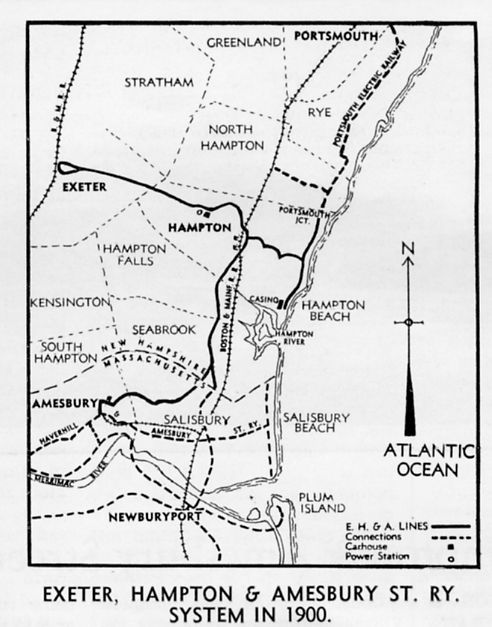
Early in the spring of 1899, the Exeter, Hampton & Amesbury began building a large two-story casino near the end of its extended line at Hampton Beach. This casino when completed held billiard and bowling rooms, fruit and confectionery stands, a spacious dining room and a large hall for conventions, outings, dances, etc., and which, if the occasion required, could be speedily transformed into a comfortable theater. At the south end of the casino, a large bath house was erected, and at the rear, an athletic field was laid out. Across the street was a kiosk where band concerts were given daily. It was the boast of the street railway that this casino contained everything that a day’s or a week’s enjoyment might need.
DURING the summer months, half-hourly service was provided from both Amesbury and Exeter to Hampton Beach with the two lines joining at Whittier’s Junction (near Hotel Whittier) in Hampton Village and continuing over the same rails to the beach. After Labor Day and the ending of the summer schedule, cars ran on hourly time between Amesbury and Exeter, connections for Hampton Beach being made at Whittier’s. In Exeter a separate car provided half-hourly service on the loop during certain hours of the day.
On July 28, 1900, the Portsmouth Electric Rail way completed its extension from Rye Center to North Hampton Beach, and direct service from Portsmouth to Hampton Beach began. At first it was necessary to change cars at Portsmouth Junction (the connection of the two railways at the Hampton-North Hampton town line) but later, through cars were placed in operation, using equipment of both the Exeter, Hampton & Amesbury and the Portsmouth Electric, crews being changed at the “transfer,” as Portsmouth Junction was also called. This arrangement was followed through the summer only. In winter, the Hampton Beach car, in addition to running to the Casino, connected with the Portsmouth car at the junction. Through cars were also operated between Newburyport and Exeter for a time, crews and registers being changed at Smithtown, and schedules of the Exeter, Hampton & Amesbury and the Haverhill & Amesbury were correlated to provide positive connections at Amesbury.
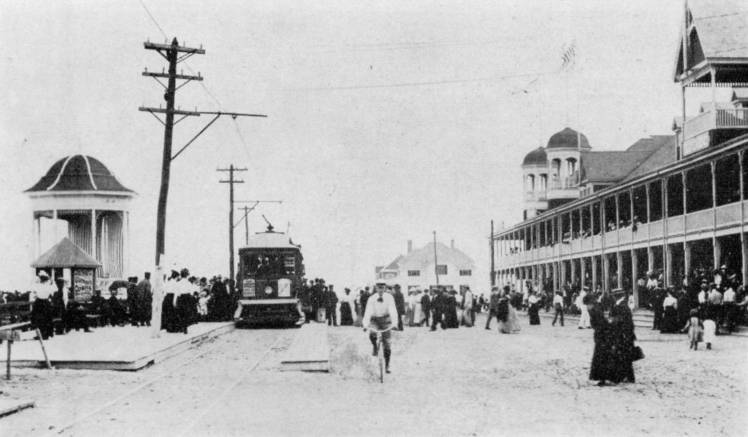
HAMPTON BEACH, 1901 — Car shown is one of the Briggs-built 14-bench double truck opens built for the Exeter, Hampton & Amesbury St. Ry. in 1900. In later years with the building of the line from Smithtown through South Seabrook to Seabrook and Hampton Beaches, a long siding was built in front of the Casino [Photo from collection of O. R. Cummings]
SINCE both the Exeter, Hampton & Amesbury and Amesbury & Hampton Street Railways were controlled by the same interests and were under a single management, the next step was the lease of of the Amesbury & Hampton to the Exeter, Hampton & Amesbury, actual consolidation being impossible because, at the time, there were no laws in either Massachusetts or New Hampshire to permit the merger of companies of separate citizenship, even though physically connected. The lease went into effect on July 1, 1900, with the Exeter, Hampton & Amesbury agreeing to pay as rent a semiannual dividend of 2 per cent of the Amesbury & Hampton’s capital stock, to keep the property in good repair and to operate the same in accordance with Massachusetts laws governing street railways. The Amesbury & Hampton, in turn, was to maintain its corporate existence and to issue any stock or bonds that might be necessary to pay for any permanent improvements to its property.

During the summer of 1899, the Exeter, Hampton & Amesbury was awarded a contract to carry mail between Exeter and Smithtown, with three trips a day, Monday through Saturday, to be operated between Exeter and Hampton Falls and two trips daily except Sunday from Exeter to Smithtown. The regular cars were used for this service until March 1, 1900, when a railway post office car was placed in operation. This car, designed by the general manager and built by the Newburyport Car Co., was a single truck affair and was divided into two compartments, one for mail and the other for baggage and express. It made three round trips daily except Sunday between Exeter and Amesbury and connected with mail trains of the Boston & Maine Railroad at Exeter and at Hampton.
Many improvements were made on the Exeter, Hampton & Amesbury – Amesbury & Hampton system in 1899 and 1900. The Hampton carhouse was increased 15 feet in length; grade crossings at Hampton Village and on the Hampton-Smithtown line were eliminated by construction of overhead highway bridges; a new Cross compound engine, coupled to a generator rated at 250 kilowatts and 550 volts, was installed in the Hampton power house; additions were made to Hampton Beach Casino and a new hotel, the “Ocean House,” was built at Hampton Beach. (Both the Casino and the hotel were still operating in 1950). During periods of heavy traffic, it was necessary to purchase additional power from the Amesbury Electric Light Co. which also supplied energy to the Haverhill & Amesbury Street Railway for a number of years.
New equipment was acquired by the Exeter, Hampton & Amesbury in 1899 and 1900. Three 10-bench single truck opens and a single truck “Duplex”-an early type of convertible-were purchased from the Briggs Carriage Co. in 1899. One 10-bench open was wrecked when struck at the Hampton grade crossing on August 29, 1899, by a freight train. In 1900, three more 10-bench opens, built by the Newburyport Car Co., were purchased and two 14-bench double truck cpens, identical to those of the Amesbury & Hampton Street Railway, were acquired from Briggs. In addition, two double truck snow plows, one built by Taunton and the other by Smith & Wallace, and a second 4-wheel flat car, constructed in the Exeter, Hampton & Amesbury’s shops, were added to the roster.
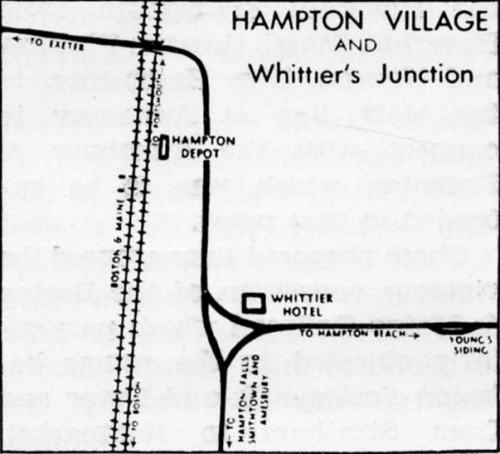
The general offices of the company were located in the Folsom block on Water St., Exeter. Here were quarters for the superintendent and the clerical force, a waiting room for passengers and a large private room for the use of the directors. There was also an office and waiting room on Market St., Amesbury, and in Seabrook the management arranged with the proprietor of an old curiosity shop to use his store as a waiting room. This was mutually satisfactory as it saved the company the expense of erecting a building, and at the same time, it brought possible customers into the shop. At Smithtown Square, a lunch room was the waiting place.
In connection with the Exeter, Hampton & Amesbury, lines were proposed from Exeter to Epping; from Exeter to Fremont and Chester and from Hampton Village, along the Lafayette Highway, to Portsmouth; but none of them ever progressed beyond the planning stage.
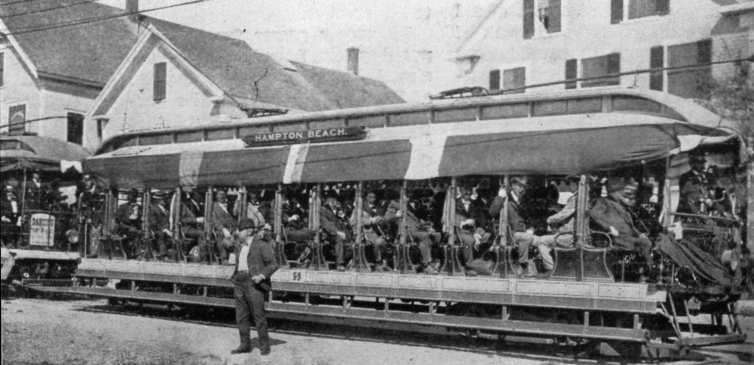
NO. 59 AT HAMPTON CENTER, on a Masonic outing in 1901. Car later became No. 69 of the Massachusetts Northeastern Street Railway. At the left can be seen one of the Briggs 14-bench opens of the Exeter, Hampton & Amesbury Street Railway [Photo from the T.E. Marr Studios, Boston]
The Lovell System
COMPLETION of the Exeter, Hampton & Amesbury-Amesbury & Hampton system was but the first phase in Lovell’s grand plan for an extensive network of electric railways in southeastern New Hampshire and northeastern Massachusetts. Early in 1900, he and several new associates formed the Massachusetts Construction Co. for the purpose of building this great system, and later that year organized three operating companies: Portsmouth, Great Bay & Dover; Portsmouth, Exeter & Newmarket; and Haverhill & Newton Street Railways.

STRATHAM CARHOUSE of the Portsmouth & Exeter St. Ry. Car shown is No. 60 or 66 of the Hudson, Pelham & Salem St. Ry., a Massachusetts Northeastern St. Ry. predecessor. The carbarn was closed in 1912 [Photo from Gerald F. Cunningham]
The Portsmouth, Great Bay & Dover proposed to build from Portsmouth to Dover via Newington, Greenland, Durham and Madbury; the Portsmouth, Exeter & Newmarket from Portsmouth through Greenland and Stratham to Exeter and from Stratham to Newfields and Newmarket; and the Haverhill & Newton from Haverhill, Mass., through Plaistow and Newton, New Hampshire, to the state line at Amesbury to connect with the Amesbury & Hampton which was to be extended to that point.
These proposed lines aroused the vigorous opposition of the Boston & Maine Railroad which particularly objected to the routes between Portsmouth and Dover and from Stratham to Newmarket. After several conferences, agreement was worked out whereby the Boston & Maine withdrew its opposition to the PortsmouthExeter route and the Haverhill to Amesbury via Plaistow and Newton route; and Lovell, in turn, agreed not to seek charters or franchises to build from Portsmouth to Dover or from Stratham to Newmarket.
To supply power for his proposed system, Lovell purchased the electric light, power and gas plant at Portsmouth, N. H., and a portion of the adjoining former Frank Jones Brewery property, and on October 30, 1900, he organized the Rockingham County Light & Power Co. to take over, enlarge and develop the plant for its intended use. On December 5th of that year, having acquired large tracts of land at Seabrook and Hampton Beaches, he organized the Granite State Land Co. to handle the development and sale of this real estate and to build a mile-long wooden bridge across the Hampton River between the two beaches.
Early in 1901, Lovell in rapid succession organized the Portsmouth & Exeter, the Seabrook & Hampton Beach, the Haverhill & Plaistow, the Haverhill, Plaistow & Newton and the Dover, Somersworth & Rochester Street Railways. All except the Haverhill & Plaistow were New Hampshire corporations. The Portsmouth & Exeter was chartered on March 7 to build from Exeter, through Stratham and Greenland to Portsmouth; the Seabrook and Hampton Beach on March 23 to build from Smithtown Square through South Seabrook to and along Seabrook Beach and across the Hampton River bridge to Hampton Beach; the Haverhill, Plaistow & Newton on March 26 to build from the state line at Plaistow, through Plaistow and Newton to the state line at Amesbury to connect with the Amesbury & Hampton Street Railway; and the Haverhill & Plaistow (in Massachusetts) on June 5 to build from downtown Haverhill to the state line at Plaistow to connect with the line of the Haverhill, Plaistow & Newton. The Dover, Somersworth & Rochester was incorporated in March and on July 1 absorbed the Union Electric Railway of Dover and Somersworth, and took over the franchise of the Rochester Street Railroad (not yet built).
All of the foregoing companies, except the Haverhill & Plaistow, were leased to the Exeter, Hampton & Amesbury Street Railway on July 1, 1901, the terms of the leases being similar to those in the lease of the Amesbury & Hampton to the Exeter, Hampton & Amesbury a year earlier. The Haverhill & Plaistow, because Massachusetts legislative permission was needed, was not leased to the Exeter, Hampton & Amesbury until July 1, 1902. The purpose of the leases was to effectively consolidate the various companies into a single operating unit and to place them under one unified management.

No. 28, bearing the name of the Haverhill, Plaistow & Newton Street Railway, poses for its picture at Newton siding, Newton, N.H., in the fall of 1905. The car was later taken over by the Massachusetts Northeastern Street Railway, and it was lost in the Merrimac carhouse fire of Feb. 29, 1916 [ Photo from collection of O.R. Cummings]
When the Seabrook & Hampton Beach Street Railway sought its charter to build along Seabrook Beach, the Haverhill & Amesbury came forward with a franchise issued to the Black Rocks & Salisbury Beach Street Railway — a Haverhill & Amesbury predecessor in 1884 — authorizing the company to build over practically the same route the Seabrook & Hampton Beach sought to construct. The affair finally came before the New Hampshire Supreme Court which ruled in favor of the Seabrook & Hampton Beach Street Railway.
Construction of the new lines began almost immediately, and since it was expected that the system would last “forever,” little expense was spared. Heavy 60# and 70# “T” rail, ballasted with crushed rock, was used throughout and where curves were necessary they were properly banked to permit fast running. There was quite a bit of private right-of-way, particularly between Plaistow and Newton, but the majority of the routes were side-of-the-road lines. Block signals and a telephone dispatching system were installed to help facilitate safe and efficient operation.
Modern brick carhouses were built at Stratham, Plaistow and Hampton, that at Hampton being directly across the road from the old wooden barn of the former Exeter Street Railway. Rotary substations were constructed at Stratham, Amesbury and Plaistow as parts of the carhouse buildings in those towns, and at Hampton in an annex to the old Exeter, Hampton & Amesbury power station. In addition, a portable substation was set up in a railroad-type box car for use at Seabrook Beach during the summer months, and at Rochester (on the Dover, Somersworth & Rochester) during Fair Week in the fall. There was also a permanent substation at Central Park, Somersworth. The Hampton, Stratham and Somersworth substations were connected directly to the Rockingham County Light & Power Co.’s Portsmouth plant, and from Hampton, high tension power lines radiated to Amesbury and Plaistow and to Seabrook Beach.

At the same time, the Massachusetts Construction Co. placed a large order for passenger equipment with the Laconia Car Co. Delivery of the cars began late in the spring of 1901, and after being equipped with trucks, motors and controllers at the carhouses at Amesbury, Hampton and Somersworth, they were immediately put into service on the Exeter, Hampton & Amesbury and the Dover, Somersworth & Rochester systems to replace old single truck cars which were placed in storage.
Lovell had been financed by a syndicate of New York bankers, and during the latter part of 1901, they retained the services of the electric railway engineers, Sanderson & Porter, to appraise the Lovell properties and estimate their probable earnings. In this appraisal, the opinion was given that the net profit of the Lovell system, after expenses and taxes, would not be less than $385,000 annually, and that the various companies comprising the system would pay handsome dividends on their capital stock.
The New Hampshire Traction Co.
INFLUENCED by the report of Sanderson & Porter, the syndicate decided to retain the electric railway system Lovell had created, and accordingly organized the New Hampshire Traction Co. as a holding corporation to take over the securities of the properties they had financed. On November 19, 1901, this company was chartered under the general laws of New Hampshire, and to the Traction Company the syndicate transferred the stock and bonds which represented the capitalization of the Exeter, Hampton & Amesbury, the Amesbury & Hampton, the Seabrook & Hampton Beach, the Portsmouth & Exeter, the Haverhill, Plaistow & Newton, the Haverhill & Plaistow, the Dover, Somersworth & Rochester and three other street railways; the Rockingham County Light & Power Co. and the Granite State Land Co. Excluded from the securities taken over by the Traction Company were all of the Exeter, Hampton & Amesbury’s mortgage bonds, held by the American Loan & Trust Co., and a large percentage of the bonds of the Amesbury & Hampton and the Dover, Somersworth & Rochester Street Railways, held by other parties. The Traction Company then proceeded to expend large sums of money for the completion of electric railways and other properties of its subsidiaries, the necessary funds being obtained through the sale of its own securities.

A 1900 Schedule
Shortly before operation of the new lines began, the Traction Company designated the Exeter, Hampton & Amesbury and the railways leased thereto — with the exception of the Dover, Somersworth & Rochester — as its Eastern Division. The Dover, Somersworth & Rochester lines became the Northern Division.
Operations
THE FIRST of the Eastern Division’s new lines to operate was that of the Haverhill & Plaistow, the Haverhill, Plaistow & Newton and the Amesbury & Hampton Street Railways from Haverhill, through Plaistow and Newton, to Amesbury on May 8, 1902. A week later, on May 15th, when the Hampton River bridge was formally dedicated, through service from Haverhill to Hampton Beach began, with cars running over the Seabrook & Hampton Beach Street Railway from Smithtown to the beach instead of following the old Exeter, Hampton & Amesbury — Amesbury & Hampton route through Hampton Village. The Portsmouth & Exeter Street Railway did not begin operation until September 11th of that year.
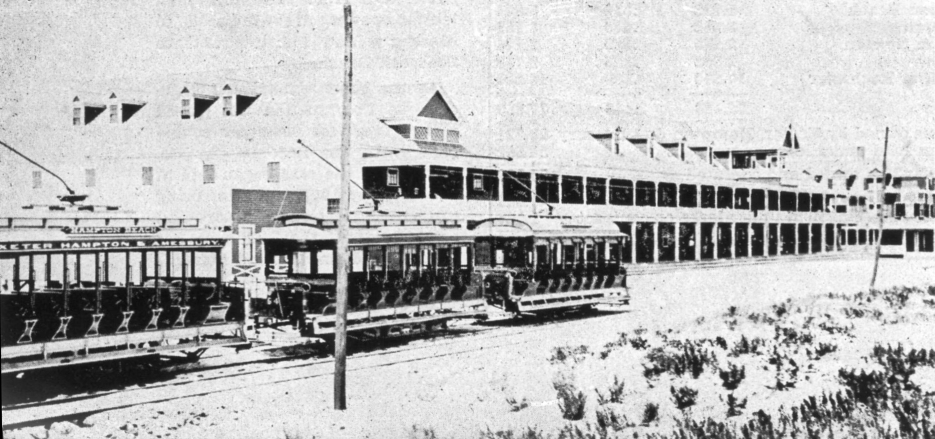
EXETER, HAMPTON & AMESBURY No. 1 and Nos. 54 and 40 of the Haverhill & Amesbury St. Ry. at Hampton Beach in 1900. In background is the Casino and the Ocean House [From collection of O.R. Cummings]
The main line of the Eastern Division during summer months was its Haverhill-Hampton Beach route over which service was run from late spring until the beach season closed shortly after Labor Day. In the fall, winter and spring, main line operations were changed, with cars running from Haverhill to Amesbury and from Amesbury to Hampton Village and Exeter.

Other routes of the Eastern Division during the summer were from Smithtown to Hampton Village and from Exeter to Hampton Beach. The Portsmouth-Exeter line was a year-round operation. Another summer only operation was the through service between Salisbury and Hampton Beaches, provided in co-operation with the Haverhill & Amesbury Street Railway.
With the change in main line operation after Labor Day, the Smithtown-Hampton Village and Exeter-Hampton Beach lines were combined into the Amesbury-Exeter route, service to Hampton Beach being provided from Whittier’s Junction by a car which also connected with Portsmouth cars at Portsmouth Junction. Operation of the Seabrook & Hampton Beach Street Railway was annually suspended from November 1st until May 1st.
On the Portsmouth-Exeter line there was a track connection with the Portsmouth Electric Railway at Portsmouth Plains, and on certain trips, Portsmouth & Exeter cars operated by Portsmouth Electric Railway crews ran through to Market Square, Portsmouth. In later years, this operation was discontinued and through passengers were required to change cars at the Plains.

SMITHTOWN SQUARE, Seabrook, in the early spring of 1909. Cars shown left to right are: No. 12, Briggs 20′ closed; No. 18, the mail car, and No. 8, another Briggs 20′ closed. The building in the center was a lunch room and served also as a waiting station [Photo from Collection of Charles C. Holt]
Deficits and Receivership
THE GLOWING predictions of Sanderson & Porter that the Lovell system would be a huge financial success were far from being correct. Instead of a $365,000 profit, at the end of the first year of operation there was a deficit of nearly $400,000, and this was repeated, although the amount varied somewhat, in succeeding years. The New Hampshire Traction Company and its subsidiaries, particularly the Exeter, Hampton & Amesbury Street Railway which was burdened with the deficits of its leased lines, found themselves in dire financial difficulties and were forced to reorganize.

The Traction Company was succeeded by the New Hampshire Electric Railways, a voluntary trust organization, on August 24, 1905, and on November 30th of that year, the Exeter, Hampton & Amesbury Street Railway forfeited its bond interest and was abandoned to its bondholders who immediately instituted foreclosure proceedings. On May 14, 1906, Allan Hollis, representing the bondholders, was appointed as receiver of the railway.
Coincidental with the receivership of the Exeter, Hampton & Amesbury, its leases of the Amesbury & Hampton, the Seabrook & Hampton Beach, the Haverhill, Plaistow & Newton, the Haverhill & Plaistow, the Portsmouth & Exeter and the Dover, Somersworth & Rochester Street Railway were cancelled as of December 1, 1905. By agreement of the Exeter, Hampton & Amesbury’s bondholders and the New Hampshire Electric Railways, the Exeter, Hampton & Amesbury routes were continued to be operated by the latter until December 31, 1906.*
[*The Amesbury & Hampton, the Seabrook & Hampton Beach, the Haverhill & Plaistow and the Haverhill, Plaistow & Newton Street Railways were consolidated with the Massachusetts Northeastern Street Railway on April 2, 1913; the Portsmouth & Exeter Street Railway was abandoned in April, 1912.]
By order of the Superior Court of Rockingham County, the assets, properties and franchises of the Exeter, Hampton & Amesbury were sold at public auction on March 10, 1908, the purchasers being a committee of the bondholders.
The Exeter Railway & Lighting Co.
TAKING possesion of the property on April 1, 1908, the new owner’s incorporated under the old name of the Exeter, Hampton & Amesbury Street Railway, and on the same day organized the Exeter Railway & Lighting Company as a holding concern to own the securities of the street railway and of the Exeter & Hampton Electric Co., a new corporation designed to take over the lighting and power business of the Exeter, Hampton & Amesbury.
Since the original power station of the Exeter Street Railway had been dismantled following construction of the Hampton rotary station, the Exeter & Hampton Electric Co. contracted to purchase its energy from the Rockingham County Light & Power Co. which also supplied the power for the street railway.
When the receiver took over the street railway, he found the roadbed and equipment barely capable of operating, and it was necessary to rebuild a large portion of the system and to provide many improvements, particularly at Hampton Beach. All of this was done through a cash outlay of $40,000, principally derived from money borrowed on short term notes. The program of rehabilitation was continued by the reorganized Exeter, Hampton & Amesbury Street Railway which spent more than $24,000 on repair and reconstruction of track and roadbed during 1908 alone!
Late in the evening of Friday, March 1, 1907, the old Hampton carhouse burned to the ground with a loss of six 10-bench opens, all of that type owned by the railway which had been in storage for the winter months. Because of the relative proximity of the summer season and because car builders could not promise delivery of new equipment until September, it was necessary to look about for second hand cars. After quite a search, six single truck opens were purchased from a line in upper New York State, brought to Hampton, repainted and renumbered, and immediately placed in service. At the same time, the Exeter, Hampton & Amesbury built two 14-bench double truck opens in its own shops. Patterned after the two Briggs opens, the new cars had a seating capacity of 84 instead of the customary 70.
During 1909, a single truck closed car body was acquired from the Amesbury & Hampton Street Railway and a 10-bench open car purchased from the Public Service Railway, Newark, N. J. Another single truck closed car was secured second hand in 1907.

Operation of the railway post office car was discontinued about 1910, but the Exeter, Hampton & Amesbury continued to carry the mail between Hampton Village and Hampton Beach and from Exeter to Hampton Village and Hampton Falls for a number of years thereafter.
In reorganizing the Exeter, Hampton & Amesbury Street Railway, the original $360,000 in capital stock was cancelled and the bondholders exchanged $225,000 in bonds and accrued interest for $112,000 in bonds and $125,000 in stock of the new company. They subsequently invested $12,000 in cash for corporate purposes and received in return a like amount in stock. Through this transaction, the capitalization was reduced by nearly one half.
Fares had been increased from 5 to 6 cents by the receiver in 1907, and on November 1, 1909, the number of fare zones between Exeter and Hampton Village was increased from two to three and at the same time-to encourage riding-ticket books containing 50 coupons for $2.50 were placed on sale. The rate of 6 cents for single cash fare remained unchanged. Later, the fare was raised to 7 cents and in 1918 to 10 cents, with the fare limits between Exeter and Hampton being reduced to the original two. At this time, special 5-cent fare sections were established between the Exeter depot and Hayne’s Corner on the Hampton line, and from Smithtown to the Hampton Falls town line in Seabrook.
It would appear that the reorganized Exeter, Hampton & Amesbury Street Railway was “behind the eight-ball” from the very beginning. Dependent almost entirely upon summer patronage for the bulk of its revenue, the railway during the winter months was a decidedly losing proposition. Due to the small permanent resident population, there was little local riding, and because of the high costs of snow removal and general maintenance, whatever profit was realized during the periods of heavy traffic was more than offset by the heavy operating expenses at other times. The road managed to pay its bond interest regularly after reorganization, but in order to do so was forced to neglect necessary maintenance and repair work.
During the latter part of 1918, the Exeter, Hampton & Amesbury Street Railway filed a petition with the New Hampshire Public Service Commission seeking permission to permanently abandon the major portion of its sytem, from Exeter to the shore road at Hampton Beach and from Hampton Village to Smithtown, and for authority to discontinue, until such time as it could make reasonable arrangements for operation, the remaining part of its road which consisted of the line along Hampton Beach from Portsmouth Junction to the Hampton River bridge, and two short lines in Seabrook, extending from Smithtown Square to the Massachusetts state line and the connections with the Massachusetts Northeastern Street Railway. These two branches were owned by the Exeter, Hampton & Amesbury, but were operated by the Mass. Northeastern.
This petition was strongly opposed by the towns served by the Exeter, Hampton & Amesbury, and particularly by Hampton which felt the need of the railway to serve its property at Hampton Beach. The commission, notwithstanding the opposition, felt that the petition should be granted. It did so, but because of the desire of Hampton and the other communities to keep the lines running it postponed the effective date of abandonment until May 1, 1919, so that a law might be passed by the Legislature enabling the towns to own and operate the railway.
Such legislation was obtained and at a special town meeting on December 20, 1920, Hampton voted 155-118 to purchase the properties of the Exeter, Hampton & Amesbury Street Railway, or securities representing the same, for a price not to exceed $80,000. It was also voted to issue 25-year town bonds to pay for the railway and to appoint a board of directors to supervise operation of the property.
On February 1, 1921, the Exeter, Hampton & Amesbury Street Railway was purchased by the Town of Hampton for the sum of $76,000with 5 % bonds in that amount being sold to the American Trust Company. Because of a question of the legality of the purchase, it was not until April 6th that the Town of Hampton assumed control. During the intervening time, the property was operated by the old company for the account of the Town of Hampton.
Excluded from the property taken over by the Town of Hampton was the Hampton Beach Casino and the Ocean House, which had previously been sold by the Exeter, Hampton & Amesbury Street Railway, and the track from the Casino to the northerly end of the Hampton River bridge, a distance of .55 miles, which was conveyed to the Massachusetts Northeastern Street Railway.
Municipal Operation, Motorization and Abandonment
REHABILITATION of the railway began almost immediately after the town took over. Two of the old closed cars were equipped for one-man operation and were placed in service in October. All of the open cars were painted (for the last time) and two 4-wheel snow plows were purchased second hand from the Eastern Massachusetts Street Railway for $1,000. A new heating plant was installed in the carhouse and 2,367 old ties were replaced at various points.
At its town meeting in 1922, Hampton voted a second bond issue of $12,000 to finance further improvements to the railway. A single truck Birney car was purchased from Wason, and reconstruction of the track and roadbed continued. In their report to the taxpayers of Hampton in 1923, the directors of the street railway said that the property was in the best condition it had been for several years.
Unfortunately, municipal operation was just as unprofitable if not more so-than private management. Revenues just did not meet operating expense and the railway went deeper and deeper into debt, the annual loss being about $10,030, including bond interest and operating loss in approximately equal parts. This the Town of Hampton was obliged to make good each year.
In addition to decreasing patronage, occasioned by the increasing use of the private automobile, the railway was the victim of unfavorable weather conditions. During 1922, a rainy summer held down the riding, and in 1923 the lines from Hampton Village to Smithtown and from Hampton to Hampton Beach were out of operation from early January until April 10th because of snowdrifts blocking the tracks.
Several methods of reducing expenses were suggested by the board of directors in its 1923 report. It was recommended that operations be suspended during periods of heavy snow; that fares be raised; that financial assistance from Seabrook be sought (Hampton Falls and Exeter were already contributing to the operating expenses of the railway) and that platform costs be cut down. Some mention was made of co-operating with the Massachusetts Northeastern in running through service between Newburyport and Exeter, but as this would have meant purchase of another car by the Exeter, Hampton & Amesbury, this plan was not given serious consideration.

In 1920, the Northeastern abandoned its line from Smithtown through South Seabrook to Seabrook Beach, and on December 17, 1923, service was discontinued between Amesbury and Smithtown over the former Amesbury & Hampton Street Railway. On May 17, 1925, the Portsmouth Electric Railway motorized its system. This left the Northeastern’s Salisbury Smithtown and Hampton Beach lines as the only rail connections with the Exeter, Hampton & Amesbury Street Railway.
During the latter part of 1925, the Exeter, Hampton & Amesbury petitioned the Public Service Commission for authority to operate buses over its routes during the fall, winter and spring in order to avoid snow removal costs. This permission was granted November 5, 1925, and a single bus began running from Exeter to Hampton Village and Hampton Falls in January 1926. Actually, the service was operated by the Exeter, Hampton & Amesbury Transportation Company, organized by interests friendly to the railway. This was the end of trolley operation on the line, although it was intended to run trolleys again in the summer.
Two proposals appeared on the warrant for the annual Hampton town meeting in 1926. One, recommended by the directors of the railway, stipulated that car service from Hampton depot to Hampton Beach and North Beach only should be operated from May 30 to September 30 of each year and that buses would take over during the other months. The Smithtown branch was to be torn up and the tracks from Hampton carhouse to Exeter removed. The other proposal called for the abandonment of the railway and the sale of its assets, the proceeds from the sale to be applied to paying off all claims against the railway and the redemption of the outstanding bonded indebtedness, or as much of it as possible, incurred by the town for the purchase of the railway. The second proposal ways adopted by the voters.
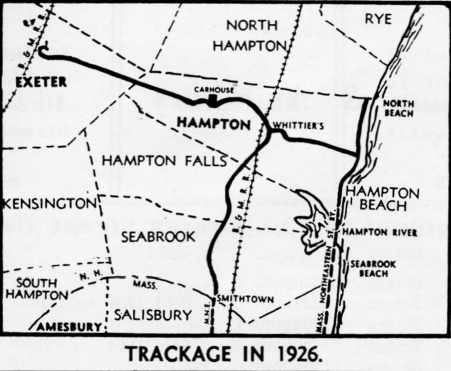
A request for permission to discontinue operation was filed with the Public Service Commission on April 26, 1926, and after a public hearing at which nobody appeared in opposition, the desired authority was granted on May 27th. While the exact date of abandonment is questionable, it probably took place on Saturday, May 29th.
Dismantling of the line began immediately, the rail and overhead being sold for scrap. On February 15, 1927, the remaining assets were placed on sale. The Boston & Maine Transportation Co. purchased the bus and some of the fare registers; the Birney car went to the Biddeford & Saco Railroad in Maine, and the remaining rolling stock, plus tools and supplies, were purchased by Perry, Buxton & Doane of Boston. The carbarn, several telephone booths, the waiting station at Smithtown and other real estate were sold to private parties. All outstanding debts were paid and $22,000 was turned over to the American Trust Co. for redemption of the bonds.
Toward the last years of the Exeter, Hampton & Amesbury’s operation, relatively few cars were in operating condition. Several of the two-man closed cars, the Duplex car and a number of single truck opens, stripped of trucks and other equipment, were jacked up on barrels in the Hampton carbarn. Following abandonment and sale of the rolling stock to Perry, Buxton & Doane, a number of the closed car bodies were sold to private parties in and around Hampton. One of them became the kitchen of a diner in Hampton Village and in 1950 was still in existence as such. Others were converted into overnight camps but subsequently were broken up.
A franchise to operate buses from Hampton depot to Hampton Beach was granted to the Boston & Maine Transportation Co. which also provided bus service between Exeter and Hampton for a few months. This latter operation proved to be unprofitable and was soon given up. In 1950, bus service from Exeter to Hampton Village was being provided by the Marshall Transportation Co., with the Boston-Portland buses of the Boston & Maine Transportation Co. serving the old trolley route between Smithtown and Hampton.
An interesting aftermath of the municipal operation of the Exeter, Hampton & Amesbury Street Railway occurred in March, 1949, when the Hampton town hall was destroyed by fire. One of the few things untouched by the blaze was an old clock which originally hung in the office of the Hampton carhouse. When the railway was abandoned, this venerable timepiece was installed in the town clerk’s office where it became known as the “$80,000 clock,” symbolizing Hampton’s final loss in its ill-fated street railway venture. Removed from the ruins of the town hall, it was stored in a safe place and later returned to useful service in the temporary town office being used in 1950.
Due to the lack of records of Exeter, Hampton & Amesbury rolling stock, the information presented in the rosters on the pages which follow is not guaranteed to be entirely accurate. Every effort has been made, however, to list each car owned by the railway during its existence and wherever possible, the equipment of the various cars has been noted.



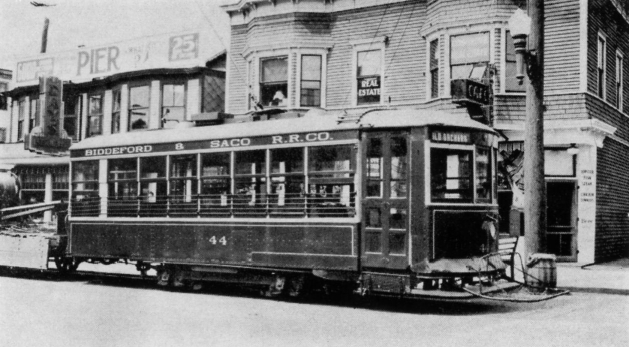
FORMER NO. 4, lone Birney car of the Exeter, Hampton & Amesbury Street Railway, saw only four years’ service on the line. Following trolley service abandonment, it was sold in 1927 to the Biddeford & Saco Railroad in the neighboring state of Maine. Photo was taken at end of line in Old Orchard in June 1935 [Photo by Roger Borrup]

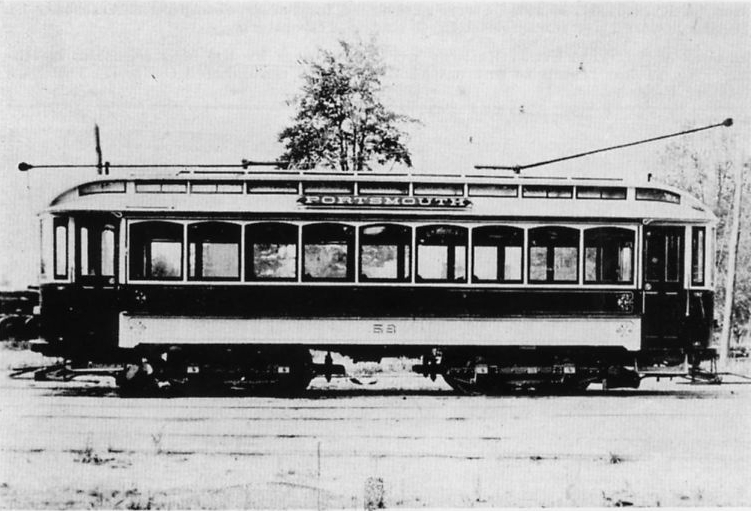
NO. 58, a Laconia-built 25-ft. closed car at the Hampton carhouse in 1901 shortly after delivery, shown without motors, resistance grids and air compressor, having been fitted with trucks and trolley poles for picture purposes [Photo from Collection of Charles C. Holt]
